Composer Elena Ruehr, a member of the MIT Music and Theater Arts faculty since 1992, premiered her new work “Requiem” at Boston’s Emmanuel Church in November 2021. Written for vocal soloists, choir, oboe, and strings, the work takes for its text a secular English translation of a Latin Mass and is dedicated to the memory of Ruehr’s mother as well as to all those who died in 2020 during the Covid-19 pandemic.
Known for her vocal music and collaboration with poets, Ruehr has written four operas, four cantatas, and a number of songs. She has also written extensively for chamber ensemble, orchestra, chorus, wind ensemble, instrumental solo, opera, dance, and silent film. Her work has been described as “sumptuously scored and full of soaring melodies” (The New York Times), and “unspeakably gorgeous” (Gramophone). “Requiem” is one of her most deeply personal compositions. SHASS Communications asked Ruehr about her inspirations for the piece and her reflections on its performance.
Q: How did writing your “Requiem” in 2020, a year of great loss for your family alongside great loss on a global scale, relate to the way you think about the meaning and purpose of requiems?
A: My mother, Ruthann Richwine Ruehr, passed in January of 2020. She did not have Covid, but as we lived through the pandemic in March and April the two events became connected in my mind. It seemed important to pay homage to the memory of those who had died, and a requiem is one of the most noble ways I know of to do that. My husband, Seward Rutkove, who is a physician, suggested I dedicate a requiem to all who passed in 2020.
I understand a requiem from the point of view of a classical music lover: There are ancient requiems from the Middle Ages, and modern requiems like Stravinsky’s “Requiem Canticles.” I am probably most moved by Mozart’s “Requiem,” which is one of the most beautiful pieces ever written, and Brahms’s “Requiem,” but there are many more. To me these great works of art are noble because they express the sorrow of loss but also celebrate the beauty of life.
I think when we lose someone we also stop and consider our own lives and we stop to think exactly how we live. It seems important to me, as an artist, that we live beautifully and embrace our time as best we can. Music, for me, is a way to both experience and express time in the most cogent and precise way, and we experience time in music as an expressive and powerful event.
Q: With all of this background in mind, how did you approach the composition?
A: I was very aware of other requiems from great artists of the past, and I tried to tap into that tradition while still expressing something modern. The ancient aspects of my piece have to do with the way the chorus interacts with the soloists and the orchestra. The modern aspects of the piece have to do with how that music changes in a larger sense of form. For instance, the harmonic construction of the middle movement, “Oh Have Mercy,” is based on a modern 12-tone harmonic structure. Listeners might not notice this, however — and I don’t intend them to. The idea is that a very repetitive and simple idea is spun out in a complex way.
Q: How did basing the text on a Mass help you evoke the experience you want your audience to have? And how would you describe your own experience of hearing its premiere?
A: Unlike popular music, where the words and music often come together at the same time in the creative process, classical composers usually start with a previously written text and then create the music from those words. So one of the most important aspects of writing classical music that has words is that the words must be carefully chosen to convey both the meaning and sound of the music. Musical text needs to be like poetry rather than prose, for instance, as the rhythms and sounds of the words influence the musical sound.
I considered many texts before deciding on an English translation of a Latin Mass. I was reluctant at first to use a Latin Mass for a few reasons. I wanted to write a requiem in English because it was my mother’s first language. And I wanted to write a secular requiem as I hoped that the music would be inclusive of people of all beliefs, including those like my mother, who was an atheist. After reading a number of English translations of simple requiem Masses, I realized that if I took out the religious words and replaced them with secular words, the Mass itself could read as a kind of map of the five stages of grief, and that these stages of grief could guide the form and emotional expression of the music, from denial and bargaining through sorrow and anger to acceptance.
Turning emotions into sound is the essential nature of musical composition, a frankly magical process that I try to teach but do not completely understand. But once that map of emotional experience was clear to me, the music came as an expression of grief in a clear and immediate way.
The premiere performance took place during a service at Emmanuel Church. It was interesting to be part of a religious service, and I was honored to be included as I felt it gave my mother’s memorial a kind of gravitas that a simple concert would not have. During premiere performances, I often am reminded of how I felt in the moment I was composing the music. The movement “Oh Have Mercy,” for instance, has a kind of breath — the phrases move in and out in a very regular way like breathing, but in this case it is the very regular sound of a person on a ventilator.
At some point about two thirds of the way through the movement, that regular rhythm breaks and there is a freeing moment. For me this is the moment of my mother’s passing. When I heard the premiere I felt for a moment as if she was with me, but also as if I could finally say goodbye. I hope that others who listen to this music will feel a similar sense of release.










